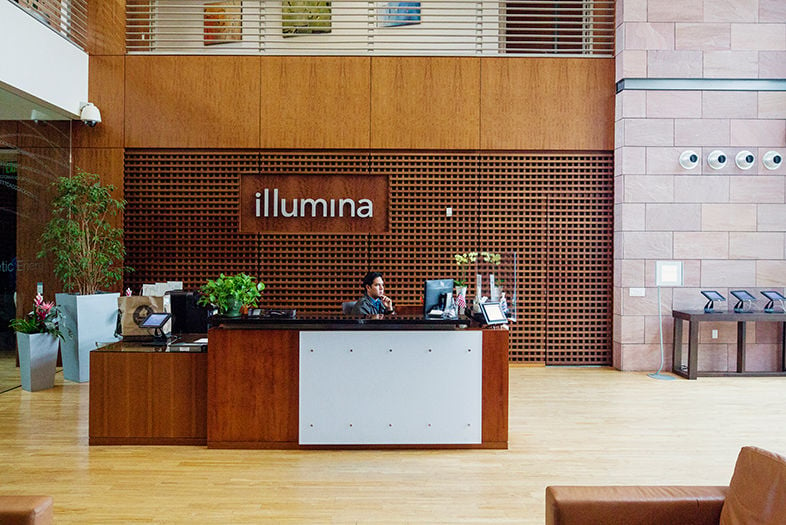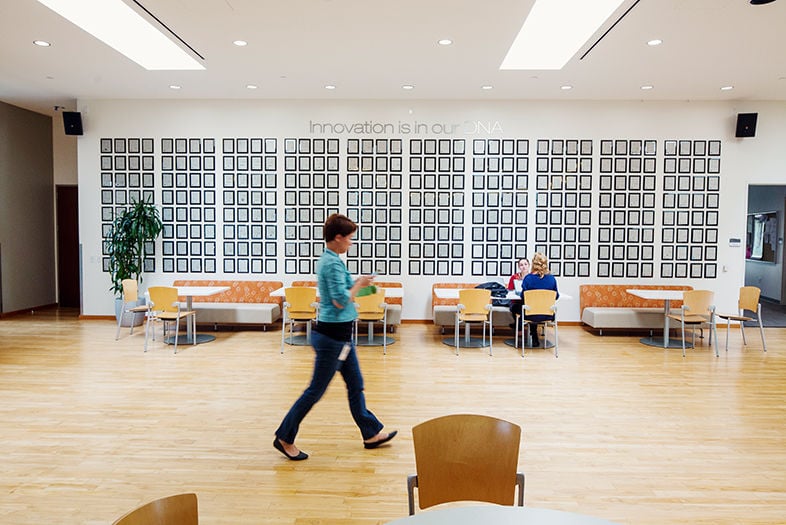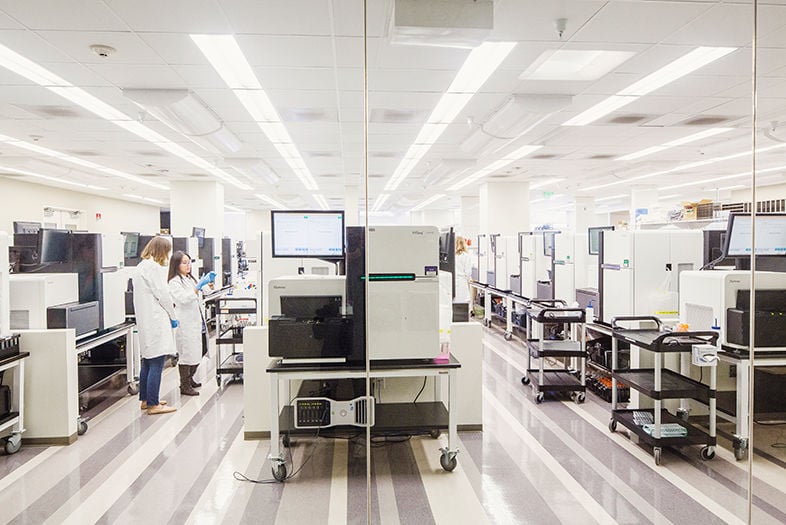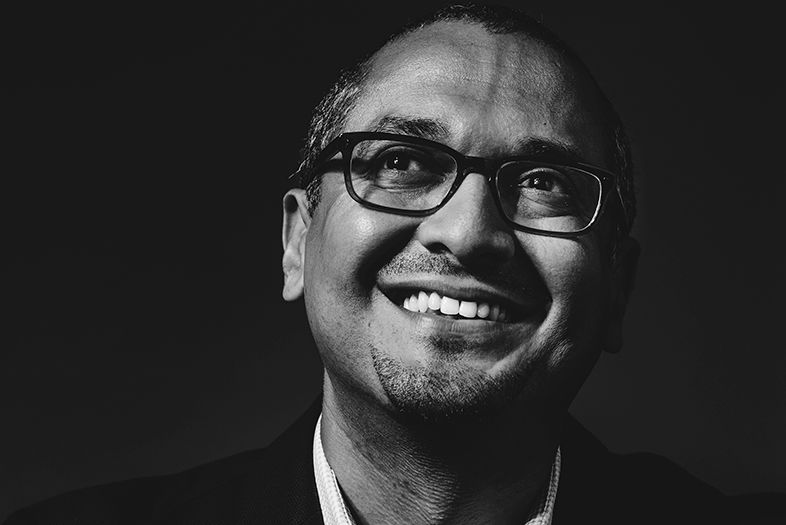Expert sequencing, innovative technology, and fast diagnoses of fatal diseases—San Diego genomics giant Illumina has made a name for itself not just in the US, but around the globe.The company even holds a Guinness World Record. Now Illumina is introducing faster, cheaper sequencing that could revolutionize how we’re diagnosed and treated. But will a new hotshot CEO be able to lead this behemoth successfully into the complex world of clinical care?
Francis deSouza was living in the Bay Area, driving the 101 from Mountain View to the city, when he got the call. Would he throw his hat in the ring to be president of Illumina, the world’s leading genomics company, and heir apparent to CEO and industry legend Jay Flatley? He wasn’t sure.
He certainly had the résumé for it. His career had zig-zagged between small startups and big corporations. He cofounded Flash Communications but joined Microsoft when they bought the company. He later cofounded Imlogic, which was acquired by Symantec, where he became president of products and services. A tech guy through and through—a serial entrepreneur with a touch of corporate fixer.
But this would be deSouza’s biggest leap yet. He went to his strengths: gathering information, integrating, analyzing. The same brain that got him into MIT at 16 went to work on this new problem. And the more he learned about Illumina and genomic sequencing, the more he was intrigued. The company was a hotbed for innovation.
“I spent nine months talking to Jay and the leadership team, and did my own research to understand what genomics and Illumina were about,” says deSouza. “I came away thinking that genomics was probably the most transformational force I’d seen in my lifetime.”
To sweeten the pot, the company was pivoting, adding clinical genomics to their impressive research portfolio. He was in.
The Big Dog
Saying Illumina leads the research genomics market is like saying Google handles web searches. The company’s instruments may generate as much as 90 percent of the world’s sequencing data. Enter any random lab, and chances are there’s an Illumina machine close by.
“Right now, they have the best instruments out there for our applications,” says Brian James, who directs the Genomics Core facility at Sanford Burnham Prebys Medical Discovery Institute. “We use a NextSeq 500 in the lab. It’s easy to use, and has been very reliable.”

The Man Behind San Diego’s $26 Billion Company
The Lobby at Illumina’s University City headquarters. | Photo: Robert Benson
Illumina succeeds, in part, with “sequencing by synthesis,” technology they picked up in 2007 when they bought Solexa. To oversimplify a complex process, Illumina machines take samples and rebuild short DNA strands. Each G, T, C, and A base is marked with a fluorescent tag, which illuminates as the bases are attached to the growing strand. Advanced cameras capture these flashes of light and computers interpret the results. The process requires advanced chemistry, optics, hardware, and software.
The technology is crazy-complicated, like building a supercollider for the genome, and the applications are all over the map: human health, criminal forensics, agriculture, energy production, paleontology, and ancestry. In 2014, they introduced HiSeq X, which made it possible to sequence an entire human genome for $1,000. (Though interpretation costs a bit more). The company seemed like it was set.
Into the Clinic
If you had bought Illumina stock in 2007, you’d be patting yourself on the back now, but the company hit a rough patch in 2016, didn’t quite make their numbers, and got punished by Wall Street. Customers weren’t buying enough sequencers.
Illumina was already moving into clinical applications: cancer, noninvasive pregnancy testing (NIPT)—in other words, much larger markets. That’s the dollars-and-cents reality, but deSouza always brings it back to people.
“The only way we achieve our mission is when a physician uses genomics to alter the course of treatment for a patient,” he says. “That’s the stage when we are truly improving human health.”
Oncology and NIPT are just a start. Sequencing could power a long list of medical applications. Genomic profiles can identify people at risk for sudden cardiac death, helping them avoid dangerous activities. Some “miracle” drugs, such as cholesterol-lowering statins, only help a small percentage of the people who take them. Pharmacogenomic studies could identify nonresponders and perhaps point to other treatments. In the future—cybersecurity willing—everyone could be sequenced at birth, providing a baseline genome to guide lifelong care.
But clinical genomics opens up a whole new set of challenges, whereas research applications are generally forgiving. Speed is important but not vital. Lives are not on the line.
To get there, deSouza’s team must sell clinical genomics to regulators, payers, patients, physicians, and hospital administrators. Illumina is spreading the gospel of genomics at meetings, conferences, and regular “Understand Your Genome” seminars, during which participants can browse their own sequences. As deSouza discovered during his hiring process, to know genomics is to love it.
For babies in the NICU, speed to diagnosis is critical. The right drugs could protect a baby from permanent brain damage. A week later is too late.
Lost in Interpretation
The other sticking point is data—large, unwieldy pools of data. Research groups have their own geeks to pore over sequences and find those little nuggets of bioinformatics gold. Hospitals often do not.
“It makes it difficult to have a machine in the lab,” says Michael Kosty, medical director of Scripps Cancer Center at Scripps Green Hospital and Scripps Clinic. “You get raw info that has to be interpreted. You can run samples and get results, but interpreting those results is often very challenging.”
Still, lots of smart people are working on the problem. Last year, Stephen Kingsmore (president of Rady Children’s Institute for Genomic Medicine), along with Illumina, Children’s Mercy Hospital in Kansas City, and San Diego–based Edico Genome, set the Guinness World Record for the fastest genomic diagnosis—26 hours.
The Rady Children’s group is working with Illumina and Edico to scale up the process and help more kids in neonatal intensive care. Fast genomic diagnoses could rule out surgeries or ensure an infant with a rare condition gets the right treatment. Speed to diagnosis is absolutely critical. In some cases, the right drugs can protect a baby with a neurological condition from permanent brain damage, but clinicians have to know fast. A week later is too late.

The Man Behind San Diego’s $26 Billion Company
Some of the company’s patents hang on a wall in the cafeteria—they’d need a much bigger space to fit all of them. | Photo: Robert Benson
“I’m impatient to get to a place where a child is in the NICU and, at day five or six, if they’re not thriving but haven’t been diagnosed with anything, they get their full genome sequenced and get to a diagnosis,” says deSouza. “It’s so obviously right.”
But Kingsmore has a strong academic infrastructure backing him up. Most clinical settings can’t start with the data—they need immediate interpretation.
“If you look at the clinical markets, they want the full end-to-end solution,” says deSouza. “The sequencers, the analytics, the informatics, the reports. We learned this in NIPT; they started with the report.”
Clinical genomics is going to be challenging enough; cancer diagnostics may be the hardest nut to crack. Kingsmore is looking at rare diseases, which are often caused by single-gene mutations, but cancers are mutation machines. Some drive tumor growth; others are just annoying bystanders. Recognizing the difference can be difficult, and tracking how multiple variations work in concert can be even tougher.
“You have to understand how these particular pathways interact with one another,” says Kosty, “so if you intervene, you’re pretty sure you’re not changing something fifty feet down the road.”
The only way to gain that full understanding is to sequence millions of people, a process that’s just getting underway in the US, China, France, and England. According to deSouza, “You need these large-scale studies to generate enough data to make sense of genomics and the functionality of genomics.”
Super Nova
To support these population studies (and pretty much every other aspect of genomics), Illumina recently introduced NovaSeq. The new sequencer incorporates improved optics, chemistry, and other refinements to accelerate and reduce the cost of sequencing. During his announcement at the J.P. Morgan Healthcare Conference in January, deSouza said the new platform might eventually enable $100 genomes. Wall Street cheered.
But perhaps the most significant application for NovaSeq is Grail, an Illumina spinoff working on liquid cancer biopsies. The idea was influenced by NIPT, which kept producing anomalous results—neither normal nor problematic for the baby. They soon realized these blood tests were inadvertently diagnosing cancer.
As tumors grow, they slough off cells and DNA, which sometimes end up in blood. Detecting a late-stage cancer is difficult. Finding a tumor before any symptoms show up? Insanely difficult. There may be only a handful of cancer-related molecules in an entire tube of blood.
“It’s that classic needle-in-a-haystack problem that requires really deep sequencing,” says deSouza.
To some degree, NovaSeq was built to tackle this problem. At a recent conference, Grail CEO Jeff Huber noted that the ultimate goal is to create a cancer blood test that, like cholesterol or blood glucose, is a routine part of an annual physical.
Genomics Everywhere
One of deSouza’s ongoing missions is to keep the company hungry. Illumina spends around 17 percent of their earnings on R&D, far more than most companies.
“There’s a thesis that says as you get bigger, you get less innovative and slower,” says deSouza. “I fundamentally reject that.”
Though NovaSeq may extend Illumina’s advantage, they are always watching the competition. In 2014, life sciences giant Thermo Fisher Scientific bought Carlsbad-based Life Technologies, picking up a healthy sequencing business.

The Man Behind San Diego’s $26 Billion Company
The Illumina clinical services laboratory, where genotyping and sequencing technology like the HiSeq line (shown here) process DNA samples. | Photo: Robert Benson
Thermo has a long way to go to compete with Illumina for the whole-genome market, but that may not be their intent. The company’s Ion line of instruments are well-suited for targeted sequencing—reading smaller DNA regions to pinpoint mutations—which could make them a threat in oncology and other diagnostic markets. With Thermo’s deep pockets, an end run into clinical diagnostics could be a real possibility.
To counter Thermo and other potential competitors, deSouza is overseeing a colossal shift in focus: more people at all levels with clinical expertise; more sites in burgeoning markets, like China; more corporate leaders from those markets; more products targeted to diseases that affect specific populations, like Kawasaki disease in Japan; better digital communications to link Illumina’s far-flung empire. Hiring is not a problem: Illumina has a lower acceptance rate than Stanford.
The company spends about 11 months a year on strategic planning, figuring out the next market, the next platform, the next application. And while deeply focused on the clinical transition, deSouza is already thinking about where genomics will go after that.
“People will see genomics everywhere,” deSouza says. “In police cars for crime scene applications, field infectious disease testing, human ID in customs and border control. They may not even know they’re using genomics. Genomics in the clinic and then genomics everywhere.”

The Man Behind San Diego’s $26 Billion Company
PARTNER CONTENT
Francis deSouza | Photo: Flavio Scorsato












